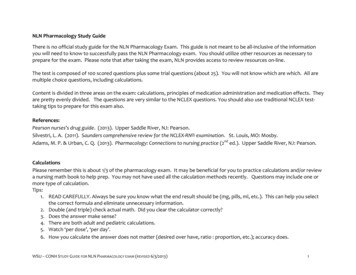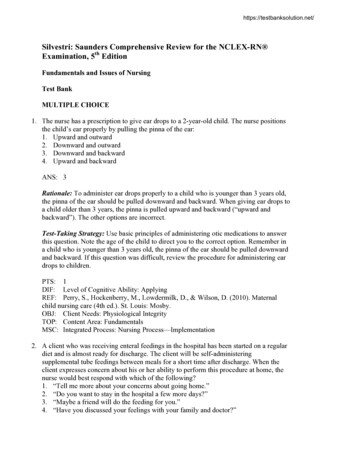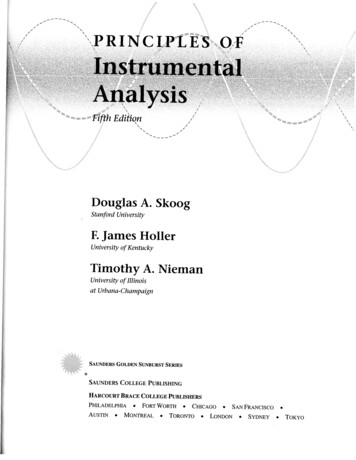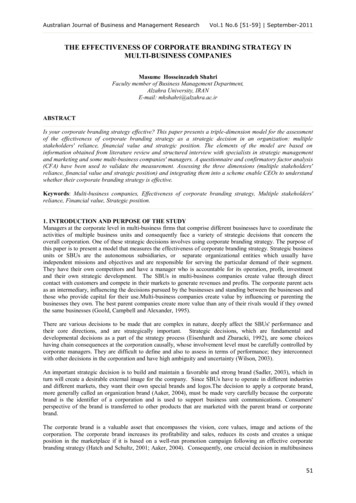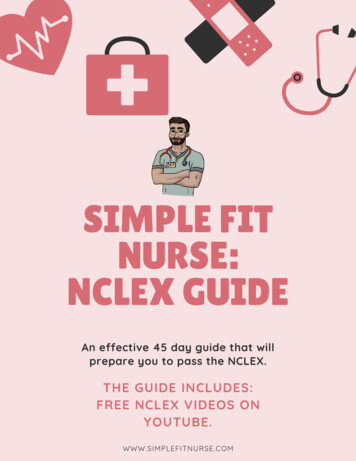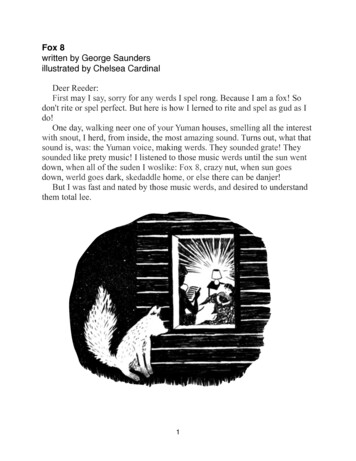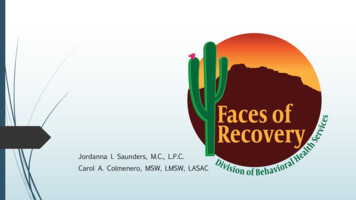
Transcription
Jordanna l. Saunders, M.C., L.P.C.Carol A. Colmenero, MSW, LMSW, LASAC
Learning Objectives1. Identify the components of Trauma in Indian Country.2. Understand the impact of Trauma on individuals andfamilies in a Tribal Community.3. Learn about how SRPMIC HHS/DBHS is creating anenvironment to enhance resiliency by using naturalsupports & highlighting substance abuse recovery.
What is Trauma in Indian Country?“Historical Trauma is a cumulative emotional andpsychological wounding over the lifespan and acrossgenerations emanating from massive group traumaexperiences.”Psychoactive Drugs.2003.Jan-Mar;35(1):7-13
Impact of Trauma Over the LifespanAre neurological, biological, psychological and social in nature.They include: Changes in brain neurobiology; Social, emotional & cognitive impairment; Adoption of health risk behaviors as coping mechanisms (eating disorders,smoking, substance abuse, self harm, sexual promiscuity, violence); and Severe and persistent behavioral health, health and social problems, earlydeath.(Felitti et al, 1998)
Unresolved Grief-Acknowledging the ProblemsResults of Unresolved Grief: The Spiritual Battle Alcoholism Drug Abuse Child Abuse Sexual Abuse Loss of Culture Identity Confusion Poverty Domestic Violence Loss of Traditions Internalized Oppression Hopelessness Anger Resentments Loss of Language Increase in health disparities: Diabetes, Cardiovascular Disease, and Kidney Disease
StatisticsLife expectancy in years:MenWomenU.S.73.276.5AI/AN66.1Disparity 7.1Total79.674.470.65.25.9Average Age of Death in AZ:General PopulationAI population72.254.7Donald Warne, MD, MPH, 2008
The Healing Journey Acknowledgement Processing- Healing Forgiveness The Art of Letting Go Moving Forward
Thinking PointsAs you watch the video today we want you to pay attention to: Are there particular individuals, scenes, images or lines that stand out for anyparticular reason? What feelings does it bring up? What ideas for action does it bring up? What do you think the masks represent?
Discussion (post Faces viewing) What are some feelings the film raised in you? What was one thing that touched you? Did you learn something you didn’t know before watching the film? What do you think you can do to encourage others to stay (not commit suicide)? What do you think you can do to encourage others who may be interested in recovery? Several Faces Participants discuss their first exposure to substance use was by a familymember. One participant talks openly about her suicide attempt and her brother’s reaction,“Why didn’t you call the police?” What options are available in your community forsuicide support? Despite the trauma and all the struggles, the participants each find recovery andthrough various means they are rebuilding their lives. The participants reference their families, their spirituality and their children. What othersupports do you hear them mention or see in the video?
Storytelling
Masks are worn for performance,entertainment, disguise, concealment, orprotection. They have been aroundsince ancient times and have been usedin ceremony, storytelling, and dramaticenactment. Making a mask invites you toexplore the persona you reveal orconceal from the world.Malchiodi, K. (2010, March 02). Cool Art Therapy Intervention #8: MaskMaking. Retrieved March 29, 2017, making
InterconnectednessAlcohol and drugs are destroying us and we want to recoverThat change comes from within the individual, the family and thecommunityThat within each person, family and community is the innateknowledge for well beingThe solution resides within each communityWhite Bison. (n.d.). Retrieved June 02, 2017, from http://www.whitebison.org/
Family and Cultural Preservation It is a family affair! Community Involvement. Preservation starts with the roots. Healing begins with the roots. Advocate for cultural and language preservation. Education Resources Empowerment Self-Esteem and Identity Tribal Sovereignty and Self-Determination
Engaging Community ResilienceWe started a discussionabout Recovery.
Letter from Faces ParticipantHello functioning Alcoholic,It’s been a while and writing doesn’t come easy for you, for you are in thepast. I left you behind cause the future for me want; bright with Alcohol inhand. Alcohol would have just caused me my job, jail time, loss of funds andtime away from loved ones, and most of all death. Alcohol just put us threw alot of anger, shame, self-pity, blame, self-destruction, it also got to where,suicide would have been an easy way out. Stupidity is the label of a can orbottle I choose to hold. I thought I looked good or bad ass, or tough. It tookme time to get from yesterday to now. Today it’s one day at a time. I alsohave principles, creator first, and choice, and what I do with that choice ishaving a happy and healthy life with a great sense of direction.-Kathleen with principles
Questions & CommentsThank you!
Carol A. Colmenero, MSW, LMSW, LASAC. Learning Objectives 1. Identify the components of Trauma in Indian Country. 2. Understand the impact of Trauma on individuals and families in a Tribal Community. 3. Learn about how SRPMIC HHS/DBHS is creating an environment to enhance resiliency by using natural

